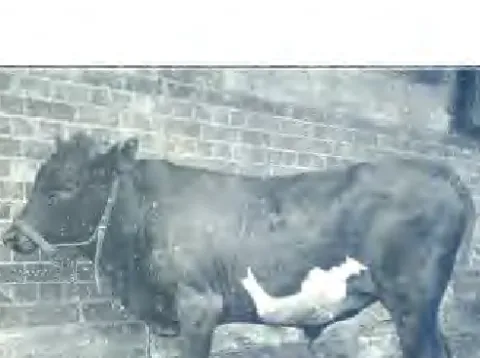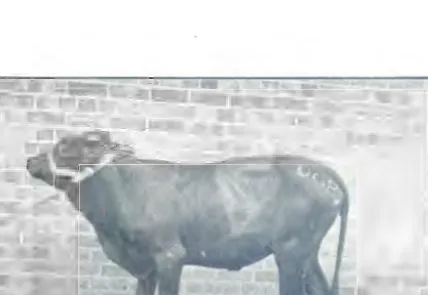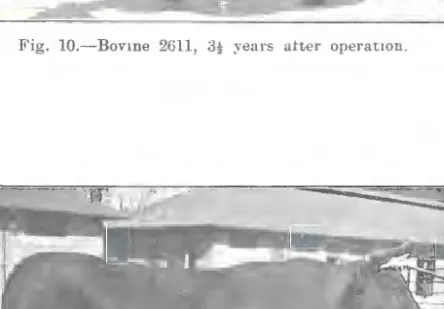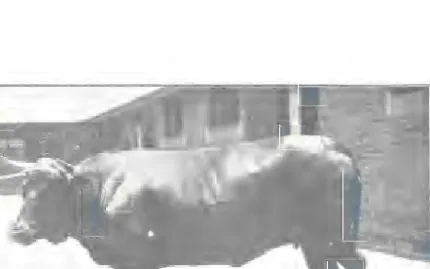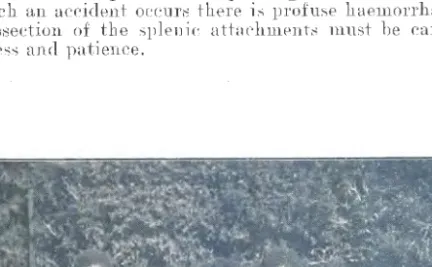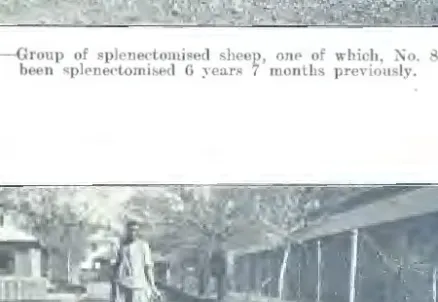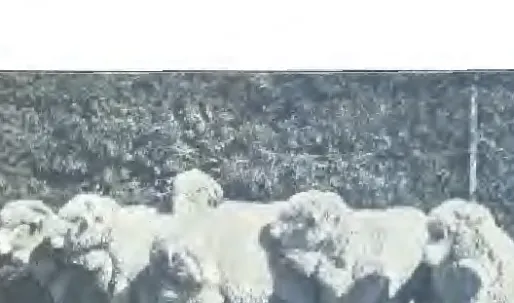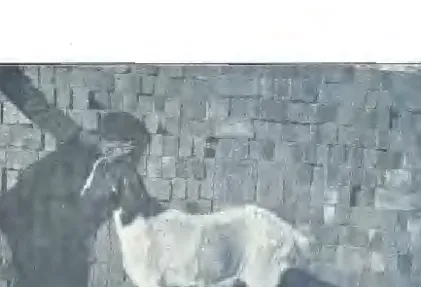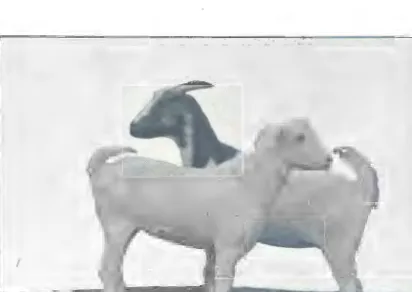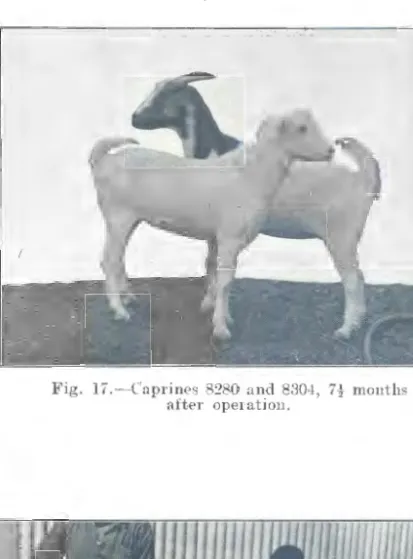Onderstepoort Jonrnlli of 1-elerilluty Science and Animal lnrlusfn;, Vol11mc
o,
.Vwu!Jcr l, July. lWFl.The Operation of Splenectomy in Horses, Cattle, Sheep, Goats, Pigs, Dogs, and some South African Antelopes: A Summary of the Results of 98 Splenectomies.
By
.J. QUIXT .• l.X, J:'.lU'.Y.S., Dr. :J[ed.
,-et. ,
D.Y.Sc., Sub-Dired01·;G. DE KOCK :JLRC.V.S., J)r. :Jle<l. \'et., D.Sc., ])eputy Director:
and
I. P. MARAIS, B.S<·.(AgTic.), B.\'.Sc., He~em·dt Officer, Onderste- poort.
\Vn llli\ 1·eceut year,; t be acl1·an('e in our kJ,o,de<lo·e of tlle function~>
of the ~ph•en an;l it~ rcile iJJ ('(:'r\<till diseasPs of i lie Gloo<l haw j11::;titird the operation of spleJiedomy as a rPcognisetl treatment in celiain
fonu,.; of anaemia in human medicine: renlol·a1 of the ~plPf>ll is no longer confinerl to cases of ~>pleni<.: iJ·auma.
In the lo,Yer an imab the operation of splelleciom)·, as a curai iYe mf>astne, has hf>en mulertaken onl,\· in the <log in the case of traumati(' injury a11d in spleJiic newgro\\·ths. There is little <louht that the u~e of the openttion can be success£ull.1· Pxten<1e<l an(l will be in the future, with the progTf>s8 of surger)· in the lower animals. The operation \Youltl snve the liYe,.; of dogs that suher hom c;pontaneous splenic rupturf>, 11·hich smnetimf>s occur,; as '' sequel to (·aninc piro- pla~mo,;is. Ho\Yf>Yf>r, ,;plenedom~- in c;mine luf>clicine is confine(l to Yeteri.nar~· specia 1 ists a n<l h<lS not Yet become a genf>ral pra('tice.
1'he opera! ioJI of splenedom)· in Yderinar.1· medi<·in<' has been mo,;tly of an experimf>11hd nature. }'or this p1npo,;e it has been carried out on <log·,; in 1nany (·oulltrif>,;. De J\.o('k alJ(L Qui1tlan (192G) operated sucef>ssfnll.l· on hor~es, <·<lith·, ,;heep, aiH1 goats. 'l'he litf>J·a- ture appears s<·anty in referem·e !o thf> operation except in the dog.
\Varthin (190~1) pnhlishe(l the Jesults of splenPctom:-- in sheep an<1 goats. His rec;ults we1·e not. satidador.1·, a;; 00 per eent. of the animalR operate<! upou di.e<l from shock. Tu this ('onuedion \Varthin'.~
results are snrp1·ising, as shoek follo\l·ing the operation has been a rare oc('unence in o1·er ni11f>ty splenf>domies performed b~· one of us ((n in the ('onduction of a series of experiments on piroplaom10sis.
theileriosis, eperythrozooniasis, anaplasmosis, and tnrpanm;omia,;is.
273
;;I'I.I·:"XE!'TO~IY I:\ JJO~IIOST]l' .\:\1.\1.\I.S .\:\II ;;().Ill·: S .. \ . . \:'\TEI.oi'I':S.
l{t>lllmal of lhP ~plPt'n ''<I' firsi i11trodu('ed at this l11,;iih1tiou to ,
-;(u!h ilw Jl<tlurP of tlw rPliculo-rndoih"lial ,;y,;t{'lll. in "·hi1·h one of
U,; (;le li_.) \\"<IS in(p]'p,;jed. ) f \\·a,; liPI-!'llll Oil t'](ll'SPS and \\'<IS folJO\\'f'(]
h_1· ~uf·h impodanl n•,;ulb thai it
,,.,h
P:deJHl<'d to l'<llile, she<'p, g-o;ds,<lllll <tlliPlojH>,; 11·ith l'(/ll<tlly illlporLtn( ,;pqudaf' (rl1• J\:ol'k and Q1Jinlan.
192(;)'
Sint:l' the ]Hthlit·<ttion "f thP alwYl'lllentionPd 11·ork ihl' u,;p of ihP opt-r;ttion h;l,; IiPPI! t-xlt-ndPll at thi;; ]n~lilnlion <h a lllP<llls of rPnd!•ring ;minlal,; .-;us!'ep(iiJ]p to ('E'!'!<Jin protozoal flis!'a.-;es antl al,;o to df'lll<lll,;ll'<th• ll'hPihE'r ihf'_l· II·PrP t·nniPJ·.-; of infPI'iion. For this puq1o.~l'
it i~ high l~- Slll't'P,;,;fnl.
'I'll!-' opt·ralion h;t,; l11'Pil <t)lpliE'tl i11 il11• slutl.l' of tilt• lift> e,vt·lf' of n•rt;tin hlood Jl<ll'aSilP,;. It h<Js hf't'll usrd in li1P diag·no,.;j,; ;tnt! till'
,.;(lll:l,y of su,.;,·pp( ihilih· <llt<l inll\lllllii_l· to disPnsf',.; cill<"h ;J,.; <Jnapb ,;lllo,.;is, pi rop[a,.;n!osis, ( r.I.JI<IliOSOilliasi;;. <I !I!] PJlPI'.\"( h rOZOOilia,;is. J,'lil (liP I' (.IJ!•
,-;~Lul' of ;;plf'nPl'tom_~- i11 thP ,;(u!l_,. "f thl' clistnu·lion of "r.l'llnon·tes, till' ntPLiholi-;nt "f iht-· pignwnl "f tiH· l1loocl, a11d the r..ti<-11lo-
"ndotlwli<1l "·""it'lll ha,; ll!'t'll apprt>l'i<ilt·<l.
'l'he rpsult,.; of t'OillJlleic>d siudil'' il<ll"l' aln•a!l,\· lH'Pil pul1lisln•!l in th .. ll!•poris or tht• l)in·dor of \'p(prinal'.\' S!•nil'{'S <IIIII .\.llilllal lnlhl.-;lry a11d in Ill!' tlnd"rsiPpoort Tount<~l. 'l'hP t':\JierintPnial 11·ork IIIJ\1. in progrl·,;s 11·ill ht> Jlllhlished latPr in thP ()ll(l!-'rslppood -lounJal.
Splt'IIPI'tollly ILI<"i ht-'l'll .-;w·l·es.-J ull_,. jH·•dorlllt'!l on horsPs, ('atLle.
slwep, goal,;, pig-,;, clog-s, and n fe11· Soul h .\ fri<"<lll antelope,;, yjr,, :
ill(' lllPc;lwk (/)amult.,t'tts 11/lufmns) <i!lll thP dniker (S.t;lr/(·oprn gri111111i .!Jrlmmi L.).
Sin1·p ,]p J\:ol'k and (JuinLtJI (UJ:_!(j) puhlishPcl th1•ir P<IJlE'l' ~OIIIP
o(IH-'1' \I"Orkf'I'S, IIRIIlg- nJn\Os( ,;imii.n lliJPl'<ltin• ic>C'hllilllll', haVI' S)Jlenedomizl'cl h111'inPs (.JJei,.;,,ner. ]!J:n. Hep,.;_ 1!):1:{). The,.;p ;n·c> ihc mth· reft'I<Plll'PS that !'<1\l hP lr<H'Pll in ilte li!Prature to thP ope1·niion in thP larg-Pr 1lonwstic <lllilll<ils. lTm\'PI"t'r, it <IJlJlP<lr,.; like!_~~, 110\1' ihat the opc•ral ioll has lJP<'II pPdormE'<I p;.;(ensil·c•l_l· and S~t('C'essfnll~·. ihat ii \l'ill hir·ilibiP till' L~Sk or l'eSt'<ll'('lt \\'0\'b~r,; in iropi(·;d nncl snh- tropil'<il l'OtlnlriPK.
l11 this p<tper ii is not i1dP1HlPtl to ll'<"<lpiiulaiP in dPL1il ihP l'l'Sttlls of rPmol·al of ihP ,;plPPII in th1• loll"l'l' ;~nilll<tlK as alread.~- puhlislH-'cl lJ_,.
<ll' 1\ot·k and llni11hn ( 11!:2!;_ I!J:li). tiP ho1·k (l!J:.!!J), dtt 'l'oii (J!):lJ),
~IPiss\IPI' (HJTI), Hl'E'S (II):;:;), \'Pil:--: <JIId 1l11 Toil ( I!J:l:.!). 'l'hp ohje1·t of til<• papPr i.-; to g·i1·1' an <ll'(·oulli "f fl1P OJH'raliH· t!•t·linique <tnd the 1\\('(ltods or ;]1\;l(''f·ltp,;ia 1\S('"· <IK 11·!'[] <IS <I -~lllllll\<1\'\' -of (!Jp I'PSUJt ohl<tillP!l iu <Jllim:d~ ~JilPllt'('\lllllisecl ,;nhsPqUl'lli io iltP ~n;t puhli1·<Jf ion or clP 1\ot·k <llld (Juinlan (IIJ:.!(i).
THE OPERATION.
l 11 thP l'<ISl' of equinPs it is alh·i-;;Jhlt• to seiPl'( _nnmg anfl small aninwl,; as the opPr<dion i,; YPl'_\· diltic·nlt <'H'Il i11 11\PlliunH.;izetl l10rses.
The first opend ion pprfol'lll{'ll was on :1.11 a1lult lll<ll'P of Slllall sizP wit It a wide open " coupling·" ThP opPrntion 11·as SlJl·CPs.'ful, hut it "·as
274
J. QUHiT.AN, (:. ])Jo: 1\0C'l\, .1Kl1 T. 1'. MAHATS.
extreme!,\· tediou~ a1Hl tiresome and, as "·ill aftenn1nls be pointed out in the paragraph on operatiw technique, the clange1· of prritonitis is very real, be('ause of the protradecl manipulation;.; \\·hich arr necessary \Yith.i.n the abdomen. .\.Hrr ihi,; fir,;i experirnce immature animals ,,·ere w.:e1l, ,,·hrn <Plr1·tio11 ,,., .. , pos,;ihle, that is hm·ses unrler two years and cattle under eighteen month,;. In one case an ox weighing seYen hunclrerl pounds \\·as oprra ted upon. Su('h an opera- tion reqnin's consi1lerahl(' pl1y,;ical 6trengih ac.: well a;; ie1·hnieal skill and should not he underiakPn b.1· surg·eons '"ith a hag·ile I'Onstitution.
The best surgical re;m]t,; ca11 lw obtained "·ith YPry slllall animals as the operation can he carriP1l out rxpedihously nn1l short ahclominal manipulation only is ne1·essnry.
'L'he ,;uh.ieds, 11·hrrr c.:election is pos;;ihle, should be iu goocl hard conditioll. Obesit.1· is m1desirahle. 11·hile Ye1·y pour animals may show shock. In the case of the smaller animals such n,; sheep, goats, pigs, anrl clogs obesity is objectionable as the suhl'utaneous and inh'a- abdominal fat some11·hat impe1le lav;~rotom_,.. This, however, is the only objec·tion.
A. TilE OrEH.ITJox :1x 11 ousE:-;.
Pr·eparat'l'on.
'l'he follo\1' i ng- precautions are b ken before ln·inging the animals into the operatiJ1!.!' theatre. The preparation includes 11ieting, purging, and sUnnng- "·ith the ob.it-d of reclu('ing- <1~ Ln a::> po,sible the volume of the stoma1·h an1l int-estines. The !lOn;rs nre put on n concentnde(l non-bulky rliet eight days prior to thP opPnliion. Tht>
diet con;;i,.;t:; of oats an1l lnan with a few pouncls of g-reen lu('el'nP daily. \VatC'r is g-i,·t-11 orl fihidum. Food an(l ,,·a(el' arr ll'ithheld alHl a milcl ptug-ati,·e :1rlmini;-;te1·e1l ~(j lwur,.; hefoTe the operation. The horses m·e l'lipped ancl "·ashe1l the 1lay preYiou,; to operating- ancl a large area oYer the left flank sb:wPcl and paintr1l '"ith tin1·ture of io(l ine. From this tim P i'tP1·il i ;~;e(l hPllrl ing on ]:1· is used in the box . . L nul's I /1 es ir1.
Ueneral an:1eHthesia i:; arloptecl. Chloral hydrate in a solution of 10 per cent. "·ith normal snline is used in comp:m,\· with l'hloroform inhalation. The cloRP giTell \·aries from 2t to 0 grams per 100 p01mcls bocly-1Yeig·ht. lt is given inh·a,·eneoush ai the rate of 50-75 c.c·. per minute. Deep auaesthesia j,; pTorlucPil h.'· ('blorofonn inhal.ltion following the injechm1 of chloral hych ate. Thr chloroform is adminisl'el·e1l tln ough a11 open mnsk.
This method of anaesthesia for equines bas been used at this Institution fOl' a num her of :-·e:ns
'"it
h ('Omplete suc·cec,;. Tn no case\\'as there the slightest 1·auM' for auxiet,\· ns to the "·elfare of the patient rluring the operation. 'J'he horse:-; J'ei·OYeTrd J'fllJidl,v hom th(• effe('t~
of the anaesthrti(' a nil d irl not ,;l1m1· "-'·mptoms of operative shock.
Techniqtle.
The patient is placed on its rig-ht ~ide on the operating i.able. The fore limbs allll head are fixecl in the mo~-;t convenient position, while the hind limbs, with the joints extenrlecl, are drawn slightly backwards so as to make the region of the flank as approaehable as possible.
275
SI'I.I<XE('TlJ.\IT IX l)(l:IIESTl(' .·1:\DI.\I .. S A.\']) S0.\11-: S .. i . .·1:\TJ<:I.OI'ES.
The ~ki11 uYr·1· the shaYeu Mea in the left tlanl; i:-; then liberallY s11abbe11 \lith elher. Tlw area ~11lTOUIHling ihe fieltl of ope1·ation i~
coYPrecl ,,·ith .-;te1·ile Jine11 "·hil'it is hPlcl in position h~· cloth forceps.
Tlte lwnfb :!Jill :~rn1s, aftp,· :1 thmough de<t11~ing ,,·it·h ,.;ynol Roap and ,,.<ll'lll \\·aiPr, arP bathed ,,·ith alcohol-l·ono,.;i,·e ~uhlimate .solution (l- 1,000). ThP\ :ll'e filwlh·rilht>cl in .·de1ile ph,1siolo~rical saline.
The in:;tn1menh, afte1· siPrili.~aiion in the auto:·LtYP, :\l'P usecl dr.1· or iransfen e1l io 'ie1·ile ph,,·siological ~aline.
j ,(/ JllltO I 0 Ill _If.
A \'Prt iC':Il i nr·ision is tnndt• through the . ..;k i rt "nd liiiiSI'Ii•s ilOII'JI
111 thP ]JPiilOIIPlllll i11 th<• 1·egio1t of tlw lt-•lt Ha11k abuut ·1-iYI' I'Pntinretre..;
lJPilinrl th1· Ltsi rih. 'l'h1· i111'ision is begun as doRI' to tlH• inlliH\-crsr p1·oce::3,.;es of i h·e lull! bar ,-pl'lPb·:~r :t:i po:; . ..;i.ble, :1,.; this posit·ion facilii:t tes
1 hP app1·o:~clt to tltP splenii' ,-ps:;t>L 11·hpn t hr 1·em:tin1lPr of i he orga11 h:ts bern mol1ilised. 'l'br lrngth of tlte inl'i...;ion YariPs fwm 15 l'll1. to :::, 1·m. :Wl'Onling· to 11·hc•thPr thr p:d ient i;:; a Slllall or brge animal.
In l:ll'ge :tnim:tl...; the longer illl'i.,ion i . ..; nel'e.-.:s:n·.' :ts llllth h:ttHls an1l :tl'li!S JIIU'it lw u~Prl inside lbr al1dontt·'ll nt th1• s:tnw time. IIarnwnl1agt>
i..; IIIli\' <llTI'Stl'll. The peritoneum is l'<l11ghi up in <1 forl'eps and inr·ised i11 the tlirPr'iimt of the l'llhtneous inC'i..;ion for <1 1list:tiH'P of <~hout 1wlt :111 inch.
~~ large pie1·e of c;terile gauze is pbcecl oYer ihl' fidel of operation :tnd a11 inl'i~ioll nwrlP thro11gl1 it oYPr ihe length of the \\'IHIIlrl. The gm1ze is :Jtt:tdtrcl to the lips of the ,,·onnrl h.\- HUhtres or forceps.
NuhtrPs :He prefer:tble as they clo Jtot intt>dere 11·iih later manipula- i ions. 'l'hr peritoneum i;; itwluilPrl in thr sutures. It i...; grarhwll.1·
opend as the suturi11g e:-.;te11rls to11 m·lls the e-:drPmitiPs of the i11cision.
'.l'he suture mah·ri:tl is not l'Ut oft ,;hort hut. is loopell so that it may be userl for rhlating i he wound ,,-hen necessary.
\Yhen mobilising the ,;ph•en the relation,.; of tl1e iutr:t-<!b<lominal org:tns aJP 1listurberl as little as po . ...;sihle. To maintain thP normal Telationship it is nPC'Pso'<~ry to lea,·e thr c:tl·it:\· of the omPnium intact h:v l:tying 011 a li1w of suture;:; 11·h il'11 11·ill unite t hr g·<~sho-splen if· :m1l the grrater omentum.
The mobilisation of the splePn diftrrs SOIIle\1 h:d· in sm<~ll and medium-sizell <1nimals. In the lutier only a sm<~ll portion of the apex of ihr . ..;pleelt \'<Ill ht> ,,·ilhllra\\n. so that all ibe ligatm·rs have to l11, I'OlllfllPted \Yithin ihe :thlloJtiPil. ·ln l·nnsP(JliPJII'e l10th lwnds JlllJSt lJP uc;ecl for intra-<1bclom:inal Jnanipulation. T'sillg tine silk for lig·aturiug, operations aTe hegm1 at the apex·of the spleen. The gastro- .splenil' and grPnter o.mentum <~re l'<lllg'ht be[,,·een tlw thulllb an1l fi11g·eJ·s of tlte left h:mtl, "·l1ile tl1e right han1l ('arrying a half-circle nePdlP ancl lig:1iurt> silk i..; passer1 on·r the p:trit>tal snrface of thr
~pleen. The nertlle i~; pa-.:sr1l from l1eforr bach,·anls through the on1rnt um, allll then, haYing i,.;ol:tte1l n portion it is again passed from l1al'k to front :tntl 1rith1lra,,-u throug'h the laparotmn)-opening. The ligatme is coiHplrterl h~- knotting the :;ilk. For tlw purpose of apply- ing tension arlll abo to facilitate kuotting a :-.;hod piel'e of plated steel, one-and-a-half ind1es long, is attacherl to the hee ellrl of the ligature silk. By this mrans the fingers of the left hand working inside the abilomen can easily apply the knot. Proeeerling· in this \Yay a double
276
.f. QUIKL\.\, C:. Jll·: 1\(J('J\: . . \ND J. P. ~l.UL\1,_.
l'0\1" of ;;uture:-; is laid ou uniting tl1e gastro-:-;pleni<· and the greatPr
omPntum alon~· tlw entire lt>11gth hom tht> apt>:-; to ihe hilus of tlw splePn until the splenic Yesseb are reacherl. Tht> attadllnent is diYidt>d beh,·een th8 <louble row of ligatures b~· Hwan:-; of a long blunt-pointt>rl sci;;sors. The suspensory liganwut is then treated in a ..;imilar manne1·
until the spleen is attached onl_,. b:•; the Rplenic vessels an<l nerves.
A last rlouble ligature is pas:-;erl ar01111d thP nsseb ancl nen·es at the hilus. The spleen is then cletache<l with the :-;eissors clo:-;e to the
<listal ligature anrl \Yithdra\\·ll.
In ligating, the clm;e connection of the stomaeh with the ;;pleen
mtt.~t be remembered ancl the orgatJ proteete<l from injury. While ligating thP splenic Ye~o;els care must be pxercised that too Jllltch tPnsion is not appherl <IS the splenic Yein ma~: rupture an<l cause considerable haemonhage. To obviate this acci<lent the Y8;;spls are first clamperl "·ith a long forceps and then ligaturecl. This metho<l facilitates the application of a reinforcing ligature for extra safet:,- aftel· the spleen hns bE'eu 1·emnYe(l.
The abdominal incision i:-; then clo,;e<l in tluee lavers \l·ithout drainage. Clu·onmtise<l catgut is usecl for the peritmH~um and the musdes and silk for the ;;kin. At first t"·o tape tension sutures as
"·ell as as small gau11e drain w·ere used, but they appear to be 1m- necessary and have a disadvantage in that. there i;; more likelihood of suppuration. 'l'he wound is sealed "·ith collorlion and iorloform and coYPred with gauze and mastisol.
The operation is completed hy the application of a sterile pro- tediYe hanrlage.
In small horses the ope1·ation is not so difficult as a large p01·tion of the spleen can he withdrawn through the abdominal incision, ancl the application of many of the ligatures can be <lone under direct observation. An incision 16 em. in length is sufficient, since it is ueeessary to introduce only one hand into the abdominal caYity. In foals the apex of the spleen can be withdra,Yn and most of the omental ligatures as well as those on the suspensory ligament ('an be applied outside the abrlominal caYity. In this way the organ can be consider- ablY mobilised. 'l'hen the left hand is introduced and the remaining aitaehmenb-small pm-tion of the gastro-splenic and great omenium and the suspem;ory ligament surrounding the splenic vessels- are pressed t{)gether and caught in a strong forceps. A silk ligature is a.Ppliecl on the compressed tissues and thP spleen removed with the
SCISSOrS.
Outside this r;mall technical c·hange the operation in both small and large horses is identical.
D£/ficulties.
rrhese are chiefly concerned with the application of the ligat1ues in large horses, as the intra-abdominal manipulations are not under rlirect observation. 'l'he mobilisation of the organ shoulcl be com- pleted as far as possible hefore attempting 'vithdrawal, as it ver~'
easily ruptures anrl causes unpleasant haemorrhage. The operation causes considerable fatigue on account of the slight elasticity of the thoracic "·all and the position "·hic:h neressarily has to he assumed by the operator.
277
Frg. 1.-Equme 16072. 2 weeks after operation.
F"ig. 2.- Equine 16072, .5 weeks after operation.
278
J. QUl:'>LAN, G. DB KOCK, AND l. P. )1AilAlS.
H. THE OPJ-:I!ATro.:-; 1s c.\TTLE.
The prPparatiou, anae:;thesia, HJ}(l the laparotomy are similar to 11·hat has lwen dPsnilwd for horsPs. A slig-ht modification is, holl'- ever, neeessary with tbe position of ihe ndaueous .incision, "·hich is llla<le parallel to the last rib aml al:out 5 <·m. poRterior to iL It iR begun as high up as possiblE' in thP angle hel\Yeen the posterior rib ancl the transverse proC'essPs of ihP lumbar 1·ertehrap; a length of F>
to ~0 em. is sntficieni.
'l'he lefj hand is i.nho<luC'ecl iuto the abdomen between the rumell au<l the visceral surfn<·P of tllP splPPn. Beginning at the antero- inferior aspPet of tlw <liPH of nttnC'hlllf'nt tlw pPritoneum is pPrforaiefl along ihe line of its rdiedion from the run1en to the spleen all<l ihe connective tissue hroken <lowu lJ\· careful blunt dissection. When
<lifficulty i;, experieneNl in hrP;{king through the tissue with the fingers, as is somdimPs thP ntsP i11 a<lnlt animals, it is rut through
"·iih a long-hnndlPd sl'iflsois. .ProCPl'ding l>y means of blunl <lis- :;erlion the <leta<"hment is completed OYf'l' i hE' face of the rumen and the ad.iaeent fa<"e of i he l'eticulum, as '"ell a,; owr the left nus of ihe diaphragm, until ir JPmains athlf'hed o11i_y hy the :;pleiJir Yf',sels and nerves at the hilus. 'l'he :->pleen is the11 "·ithclra11·n aJHl the Yes~els
caught in a strong fol'cep:-;. A (louble ligature is placeo on the ves~PlR
about 2 to :3 em. hom the hilus au<l the splPen i:> (letached by cutting lwh,·eeJJ lhe lig-ahu·p,; "·ith a sci,;,ors. ThP fotcep,; i::; OJH'JH'd slowly to observe "·helher the ligaturP lw-; (·omplE'tf'ly occluded the' Pssels before releasing tlw stump.
Intra-ah<lominal manipulation shoultl he gentle an<l C'areful a~
rupture of ihe utprmle of ilw o;plef'n will cnuse profuse an(l trouhle- ::lOJlle haemol'rlwgf'.
The abtlomin<ll wound is dm,ecl b,\' suturing Lhe pt>ritouenm mul muscles with <·aig-Jtt and the ,kin with silk. Post-operaiiYe p1·otection of the 11·omHl i:-; caJTif'd oul as in equines.
Ji'ig. :1.-Bm,in~> 89+, 3 \\'ecks after operation.
279
.'-I'U:.>J-:CTO.\lY 1.\ IJlJ.\II·:"TlC .1.\DI.II .. '-' .1.\'J) .'-'0.111·: .'-.. \ . . \.\T'i-:1.01'1''-'
]i'1g. 4.- novlllr> 894, 7; months nl'ter OJW1':1tion.
Fig . .J.- Ilm·ine 891. :2 .~·ears nfter operation.
:!SO
J. QlT:\LIX, G. DJ:: Ji:OCK, AND I. P. )lAltAIS.
Fig. G.-ilovme 893, 1 month after operation.
F'ig. 7.-Uovine 893, u months after operation.
281
SJ'I.E.\"E<TO~IY 1.\" J><>\IFC'TIC _\.\"L\1.11 .. '-' .1.\"J> ;-(}_Ill·: C' .. l . . 1.\"TEI.OI'LC'.
Fig;. 8.- 110\·ine ~0:3. :2 ·"'''"'" ;tnd -1 months >lft<•r OfWration.
l•'ig. !J.- -1\111-itw :2ti! I. 10 lllOillll» after oper;ttion.
,T. QGI.\"L\X, G. IJE KOCl\:, .1:\'Jl I. l:'. MARAIS.
Fig. 10.- BovJTie 2611, 3~ years atter operation.
Fig. 11.- Bovine 2Gl1, .1 _years and :2 Hllmtlh after opcrat1on.
'283
SPLENECTOMY IN DOMESTIC -~NBIALS AND SOME S.A. AN'J.'ELOl'ES.
C. THE OPERATION IN THE SHEEP, GoAT, AND ANTELOPE.
The technique of the <liJeration in the sheev, goat, and antelope differs little from that clesrribecl in bovines. 'l'he oral administration of chloral hydrate for anaesthesia, which was used in the commence- ment, was later superceded by intraven-ous injection. The laparotomy is rlone in the same situation. The left hand is inserted into the abdomen and passed over the parietal surface of the spleen. The at- tachment between this surface and the diaphragm is first broken clomt by blunt dissection. Then beginning at the most inferior portion of its attachment to the dorsal curvature of the rumen the tissue i,;
broken clown up to the hilus. So as to prevent stripping of the peritoneum from the surface of the rumen a long curved scissors is uilecl as an aid to blunt dissection with the fingers. Small portions of peritoneum and fibrous tissues are isolated aml cut through. 1'he remaining attachment to the left crus of the diaphragm_ is broken (lown in a similar manner proceeding cranially. The detachment of the spleen is rarriecl out iu a similar 'Yay to that described in the bovine. 'l'he "·ouml in the ahclominal "·all i:-; also dosed in a similar manner. Post-operatiYe protection is carried out as in equines.
'l'he capsule of the spleen in sheep and goats is very easily rup- huecl. I£ such au accident occun; there i~ profuse haemorrhage, con- sequently dissection of the splenic attachment::; must be carried out with gentleness and patience.
Fig. 12. -0viues 28498 and 28578, nine months after ~plenectomy.
?84
.T. QUINLAN, G. DE J\OCK, .\:\D I. P. MAR.\IS.
Fig. 13.- Group of spl<?nectomised sheep, on<? of \rhich, Xo. 8429 hnd been ~plenedomised G years 7 months pre.-ionsly.
Fig. 14.-Group of splenectomised sheep, one of which, No. 16023, had been splenectomised G years 5 months previously.
280
Sl'LENECTOMY IN DOMES'l'IU ANDIALS AND SO~lE S.A. XXTELOI'ES.
Fig. 1-5.-Cnprine 8J04, 3 weeks after operation.
li'ig. lG.-Caprine 8280, J weeks n l'ter operation.
Fig. 17.--Caprines f\280 and 8304, 7-} months after ope• ation.
Fig. 18.-Ca.prines 8280 and 8304-, 2 years and 10 months after operation.
287
Fig. 19.-Caprine 8280, G years 11 months after operation.
Fig. 20.--Duiker (8ylritapra orinuni grimmi L.) 3280G, one clay after operattott.
288
- - - -
.T. QUINLAN, G. DE l{OCI\:, AND I. P. MARAIS.
Fig. 21.- Blesbuck (])anwliscus albijrons) 33606,
8~ months after operation.
D. TIIE 0PERATIOK IX TILE PIG.
The pig is also carefully prepared for the operation. Pernocton, by the intravenous route, using one of the auricular veins, is used as an anaesthetic. This method of anaesthesia for the pig is exoellent.
The dose used is 0 · 03 grams per kilogram body-weight.
'l'he route ·of approach to the spleen is immediately behind the last rib on the left side, beginning as close to the lumbar transverse processes as possible. The incision runs parallel to the rib. A short incision, about 8 em., is sufficient as the spleen can be easily and completely withdrawn through such a small opening. One or two fingers are introduced into the abdomen and the spleen drawn tb~·ough
the opening. A double series of fine silk ligatures are then placed along the splenic attachment at the hilus and the organ detached by cutting between the ligatures with the scissors. The abdominal wound is closed by thr·ee series of sutures; those for the peritoneum and the muscles being of catgut and those for the skin silk. Post-operative protecti·on of the sutured wound other than the usual seal is un- necessary.
E. Trm OPERATION IK THE DoG.
There is no difference between the technique of the operation in the dog and that described for the pig except that the spleen can be TI·ithdrawn either through a mid-ventral or a low flank incision.
Of the two routes of approach the flank incision is preferred and '''ill be used in future operations.
Anaesthesia is acc·omplished in canines by the use of subcutaneous eukodal followed one hour later by intravenous pernocton; 1 c. c. of eukodal is used for each 5. kilograms body-weight and 0 · 03 grams of pernocton per kilogram body-weight. The previous injection of eukodal frequently reduces the amount of pernocton necessary for deep and prolonged anaesthesia.
10 289
!:il'LENECTO~lY u; IJO~lESTlC AXDIAT.~ .\C\11 SO~\IE S.A. \::\Tl:J.OPES.
Fig. 22.- PorcinC', 003. 90-l, 90,) ;1nd 90G. 16 claYS after OJWration.
J•'ig. 2:3.- Por(·in,• 90-J.. 10 111onths nl'ter· opcor·atioll.
290
J. QUIKLAN, G. DE lWCK, AND l. P. MARAIS.
Fig. 24.- Porcille DQo). 10 month' <lfter operation.
Fig. 2:).- ('a n i ue I Q7:l :1i months aft0r OjWration.
291
SPLENECTO~lY IK UO~lESTIC _\C\DI.~LS _\30 SO~lE S .. -L A:t\TEI.OPES.
Fig. 2G.- C:1nincs l04J, ] 1-,t:J, 8} months after operation_
AFTE Je-T ttEA'I'~IEXT.
"\ftpr tile oper:llio11 i.he rmu11aL :nP place1l in boxes in "hich sleriliMPil hPcld1ng '" n.,e<l. It :1 p]JP<U:i to lw a useful Jn·pc:nltion, e:;pec:ially for Plluin<'S in wb ich the tetlllPncy io \WUHil infection apvean; to lw far gTeatPr tllan in ih<-' other ,;ppc-ies of animals operated upon. The prec;tntion ~~-as not tal; en cntirel_,-"·it b a ''iew to obtaining healing of the \YOlllld Jil't· Jnimam lntentiuuem, hnt also to ensuTe against the possihilit_,. of lit]; infection, "·l1ich 'nml11 h:tYe rcn1lerecl ill<• expPri!llellth 11-llic-b 11·erp hPing condur-iPd with lick-horn<• <lise:Js<•s u nsatisfa cto ''Y.
Tile foocl follm1·ing ope1·ation c·mhi:ilP<1 of :1 liglli b-xaiiYe 1·ation.
composed chiefl~r of small quantities of <·rn:ihPd oai.s \l·ith bran an1l g-reen h1cerne for horses, and maize meal 11·itli bran ancl gr<'en lu<'Ol'JH' +m· catile, sheep, goats, an<1 anielope:i. \VatPr 11·as nllo"·pcl ad l!bldwn.
Dogs and ]Jig· . ..; 11·ere fe1l 011 milk :tn1l m::Jizl\ llli':Ji ponidgL', ,,·iLl1 i.IH· a<ldition of lwPI'-rxlrac-t in thP case of <logs.
'l'ho \I'Otmds II'Pn• iuspedP1! 1lailY :11Hl ll1P <ln•,..;sing-H l'Pili'IYed. !11
i.he c::tsP of cattJP, shrep, goat-, pigs, an<l <log" there 11·as no tronl1l<·
with the 11-onnd,.;. ThPy inYarialJl~- h<'ale<l Jil'l' J!l'illlmtt 111tent'iouelll.
'!'he cnLlnPous ::;uture;; ,,.<'l'P rPlllOYe1l on ll1e srYenth or <'ig·hth clay folloll'ing tl1P opPraiiou.
In i.lle l'as<· of eq~tiLJe:-; tlw wounds eli([ .not heal h.1' :fir;;l inicni.ion.
Prohahl.v the cli:Airuliy <liclllol liP in the \YOun<l itself hut rather in tlw nature of the 1lisPase "·b ich ot·cunP<l as ::1 sequel to the rcn1oYal of the spleen, 11·here clJ:lllgPs in the blood were ::;ufficient to pre,·ent heali1tg. ]<:Yen in ihose cast's ihe incisions in the peritoneum and the intPrHal ohliqur mus..Jp ba<l unite<l, hui thPre IYas no adhesion het"·een Ll1e iJJcisPcl lip:-; of ihc P:xtPrnal ol1lique mur:wlP or thr skin. TltesP strucbu·Ps 11·en• healing undPr g-rnnJtlation "·hell the anima];;
<lierl of thP cont·uneJJ( cliscn~P. In OllP h01·.~e ll']l'ieh \Yas fre8 from
!V1lttallia eqm: infection, anrl 11·ltich reco1·erecl, ihe upper two-thirds of the \Youn<l hPa l.erl h_,. first iniPn lion lmt tl1e skin o1·er the lm1·er
292
J. QlJIKLAK, G. JlE I~OCI~, AND I. 1'. MAHAIS.
third suppurated. However, this portim1 of the "·ound healed nicel~·
under granulation. The resulting cicatrix "·as st·arc!ely visible when the animal died four mouths later a~ a rPsult of an i11tnwenous injec- tion of haemolytic serum.
SUMMARY OF THE RESULTS OF SPLENECTOMY. De Kol'k aml Quinlan ptthli:-dH·cl the rf'sulb of thPi1· flr~t ~eries of e:q1erimeJ1ts 011 splenertomisecl hm·se,. l'attlP, shf'f'Jl, <lllcl goais in 1926.
Sinr·e then obsen·atim1s have l_wen continued and Px(Pncletl to othPr species of rlomesticated animals as ,,.t>ll a~ to ,,j](l :lntelopPs. The l'Pfmlts of th(' Inter splenedolllies h:n-t' her•n puhli.-ll('d mo~lly ''~
isolatc·tl JiLtpers in ,·arimt~ sull~Pqur'tlt l{qlOrt~ of th1• Dir('ctor of YetE>ritUlry Srn-irPs. (J)e l\o1·k anrl (~ninl:1n. ·1n21; tiP 1\:ork, l!l?9; rlu 'l'oit, I 9=11 ; ~PiLe a1Hl cln 'l'oii. 19:1:2.)
Horses.
Of tlw font horst'S t>lllPllPt·tollli~erl ilnPe 11·er(' tmmtlllP" UHTteJ'S"
of Nvt;talha er[ltl <tnt\ nll tlu·<'P sl1rmerl fa!<!] rl'bpses of Xuti:tlliosis in ho1n 1 to 8 <h,vs nftPr tlH• OJlPr<ttiOJl. 'l'lw fourth animnl \\·a~ :1 ymJng foal, not a carrier of Nuttalliosis. lt "·as kept 1lllclPt' tirJ,_frep COJI- ditions fm four months foHo"·ing- thr operation "·hen it "as killed b:,·
in.iect ions of haemolytic serum.
Cattle.
FiYe animal.-; "·pre ohs('tTerl hy rle Ko<'k 8Jlcl Qui nla11 (1926 rPport) an1l Heir fimli ng~ mny be sttmmnriserl brieRy as follm,· s : -
(1) 11E>lapses of 'l'hPilerio~is (TI1cilcnn mutaus), allapla~mosis,
anrl piroplasmosis (P. bir;cmlnum) occunetl in immllllP "f'arrieJ·s"
of thes<' pnrnsite~. Piropl:t!'1110sis 1·ebpsrs \l·ere ir, 1l1rsP cases particularl:v sen•n·
(2) These <l ii':il)U~es in ~plenPdoul i-ecl nnim;ds nssttltlPil a chroni<.:
r·our~8 pnrtienLnly \Yli lt rrg-arrl iu 1lw hlooll r·hanp;P-< .
• \ 1.obl of :.!=i l1o1·i np~ \I'C'tP splPuer·tomise<l of "·lticl1 20 J·e<·OI'f'l'etl hom thr opE'nltion. Our• nnim:1l rlie1l thre(' rln',·s nftArwards, and 011
po~t modl'm 110 npp<ll'f'llt l':lltse of rlrat·l1 emJlrl hA P.-<t:1hlisl1rrl: onA rhefl ns a resnH of l1aemonhage an1l Olle hom su1gic:•l ;;hock.
Some of thP nnimaL \\'PI'e USE'rl in E,,,j-r onst feYE'l' transmission experillli'Jiis and i.ll-0 :Ill illlah \\·hich hacl l'I'COY('l'f'il from East r oast feYer wt•n• spleJIPctomisArl i.n orrler to iJ-,~· anr1 hrr•ak tl0\\'11 their immunity (du 'l'oit. 19Tl). HPIIIOYal of thr ~i'l<'('Jl was folllltl io han no effr•ct on the course of this lli-ea<(' or on 1.l1e immunity.
T 11·0 hoY ill es were s plPnPI'i omiserl for f nrth er study of i he bloorl l'ktnges in n napla.smosis. OuP animal, "Xo. -1G:27, infedprl with the mild , L. ('('Jlftalc strain, 1·e:~f'terl so srYrrcly a ftPr splenedon1Y that it cliPcl a~ tlw resnH nf tbP PxtensiYP hlno1l c-hang·es.
'1'11·0 cahes. 5os. 4G08 and .J.G7G. SllSCeptihlr to ;111aplasmosis and piropbsmosis, we1·e io.iE>r·rrrl "·itl1 hloo<l from slwep Rhowing a?WJ7lasma oris and then splenedomisecl to ;;ep 11·hether the ai/O.J7lnsmn oris \l·oulcl appear in the cahes' blood, or "·hether the f·ah·es coulrl
293
SPLENECTOC.lY IN JJOMESTIC .-IXBL\LS AXD SO~IE S.A. ANTELOPES.
become " carriers " of the disease. After the operation, however, both animals became accirleutally i ufectecl
''" j
th bovine pir.oplasmosisand anaplasmosit> and sheep sub-inoculated hom them showed no .reaction.
SheerJ.
l•'ifty-four sheep have been splen<>ctomise<l of which Re,·en died as the direct result of thP operation. In one of the latter, namr;ly No.
8462, the atta<·hment,; Of tlw splPPll \Yel'e loo~enecl and the splenic
1·e~sels ligatefl, but the Ol'l-('<1ll itself left In situ.
ThP mo;;t striking lE'-~Ult of rlP n ock :mrl (~uinhn',; oh,;erYations on sheep \\'<Is the <li,.;co1·er·5· of th<' hither·to urlSlhpt>ctr<l pres<'nce of an .:lnapla,.;ma, .I. oris, urHl a 'l'heilerin, '/'. ?'C('OIIrlitu (C":~llecl Gonrleria ovls by them) pr<',iE'rlt in tlw hloocl of ~ome South Ahi('all sl1eep.
lnaJ,!asmosls of i\hel'fJ.- The 1·e.-;ul! of thrit· ob,.;en·aiiorb ('an he ln·iefly summariser1 :~,; follo,,·,;:-
(I) 1\oJl--iJll<'rle<·tolni,;e<l "''' ept ih1P sherp Utll l>e inredt>rl hy
Jlle:~n-; of ldood inor·ul;llioll. The di,.;ease tlJPII run-; a mild
<·nurse ,,·ith <listilld :maenril' C"halll-('r's aml iiJ<' :1Jlp<'al·aJl('(·' of p::nasite,- 111 the hloocl ill larg·e llUlllhers, · but no mortality.
(2) In splenedomised can ien; ,. :111<1 spleneelomiserl sus- ceptible sheep the cour:-ie hi mucl1 more seyerE' anrl protraderl an<l there i:-; a fairl,· high modality.
(3) The JisP:l~P coul•1 not l1e iTflnsmi !.terl io splenedomisecl or 110n-splrnedomiserl hoYine;; nor <lid these animflls become ('an:iE' rs of t-lw parn site;;.
( 4) :'\ on-splenectomi -;erl gon b could not bt> in fed t>rl but in splen<->dom ise<1 g-o fits pn ra-;i tes nppr:n<>cl in the blood with ,·e1·,v slight anaemi(' changes. and sucl1 animals becmne l':nriers of tlH~ tlisPnse.
Sheep, .-;plenedomised nncl non-splenectomi:;e<l. dirl not re<lCt to l,m·ine anaplasmosis I lor rl irl illP\- hr<·omE' C<Hl'iers of t hr p:1rasites.
T/,eiln iosis of ,<.:,f,(','fl.- ])e E:ol'k nn<l Quinlan (l!l77) l't>porterl on i.lte oc·<'UlTPIICP of ThPilerin ('/'. recondi!o, G'onrle1ia oris) in the bloo<l of some splene('to1n isecl sl1Pe11. 'J'r:1 nsmi~sinn to noll-splenPdomise<l sheep nnd io hoYin<>s failed. 'l'he para~ites <lid not JH'O<luce allY symp- toms aml flJlpeanerl to he quite h:n·mless.
11 istolo.r;i('([/ (:l!on,;es.- Dr Ko('k (1!12H) l'e)HJrte<l 011 thP appNn- ance of hflPIIHI-I.nllplloi<l-likf' norlnlPs in the lin•.1· of shet'p, hovines and a goat killE'rl ilnee YE'fll'S a ftt>r splrncctomy. '.!'he JlorlulPs varied in sir,e from l in. io l~ in. in dinmeler, were <hnk re<l in <·olour. :Jn<l
<·iremnsnil>P<l. In some insh:lllce.~ a <li.stind I'H]Jsule <·oul<l hE' rrcog- llised, anrl in ol'ht>rs ther<> Wf\S no demflrcnt-ion bet"·een this foreign tis;o;ne anrl thE' liYer snbs1ancr. LYmphoi<l noclnlrs r·0tdrl bE' rerognisP<l in some of thesP structures. 'l'lw hnemo-l.vmphoirl-like norln1es werP not st>en in the nnimals 11·hich ,lie<l or 11·E're killed within the firf't two years following ,;pleJJectom~-. The -first inrlicf!tions being· foun(l in a sheep 11·hich rlie<l 30 months nftrr thr snlee11 W<tS rrmoYe<l. F1·om the microscopic appenr~mces rle nod conf'lurles that tlli~ nt>wl_,. fmnwrl tissue rest>mhles most closely tlwt of hnelllol~·mph glands.
294
J. QUIKL,\X, G. DE hOCK, AND J. P . .M.AHAIS.
Goats.
Be£01·e splenectomy the t1Yo ani mab ,,·ere inJected 11·itb. bl oo1l from
~heep showing amaplasnw hut no readior follo11·ed nor could
anaplasma be demonstrated. Splenectomy failed to p1oduce a 1·elapse
a~ in the c-ase of imnmlle C<llTier:;. SulbequeHt to the openttion, how- eYer, "·hen 1·einjPcted ibe blood KhOI\'t"d the JWest>ncP of li!W]Jlosma 11·ith prarh('ally Ho allaemic <·hnttg·e-.
The histological clwuge,; 1dtich IYere found at <Wtop;::y Oll the 011e go;d· "·hic:l1 dierl 8~ years laier kn-e beeu mentioHe<l ahoYP.
Canines.
SPveu dog,; \\·PrP succes~fnlly :;plenedont i;;e<l. ( lne ani tnal ;::ho\\·e!l lhe presen('e of 111/r·rofi/aria ill lhe l1loo<l th.ree da:,·;:; latm· aJtcl continued to sho11· these p:tnt,des uniil il died hom oiher l'<tlhl'ci. ]n no case did pi1'0j)la:;nw appe:n· i u t ltP hlooil ;t:; i.he rbult of retJtOntl of tlw splePu. Ho11·eYer, it 11·a,; only a:;,.;nmPd that tht• an:imab wpre carrier~' of f-Jiroplasmu canis as i.ht·_,. hatllJC•en exposl'd 'o iick infp,;tation, hut there can he no certainty 1ri.tlt J·eg<ml to tl1i::;. Sub.-;etptPntly three of th.esP clogs 11·eJ·e in.iecte(l 11·ith hloo(l from a l;llo\\·tl carTier of ihr disease. One of iltem diPd from piropla~mo::;i::; an<l bn1 .recoYere1l after treatment, but coni in11ed io ~ho11· p:tl';t.sile::; for wYer:1l wPeks aftl•t'-
'"a
nls.Owing to the un!'eri.aint,r 11·iilt rt>ganl to iht> prPYiou:; immunit.'·
i.t is not 11o:;~ible io tlnn,· tlefinite !'ondu,;ion:; on lhP eifect of lh1•
removal of the ::;pleen on canine piroJ!la,;mosis. 'l'he llisease, however, appPa t'e<l to a her:!' the s ple nt>dom iserl tl og.-; more :if' n•nely tlt an is t>xperience<l in clinical ease;; of the cliseast' in nonnal clogs. One of the animals showed a severt> lwemoglohinuria. j:fier;sner (1831)
reports on a fp"· ('aSPS of relap:;e:; of }Jirop]a.-;mo:;i,; follo\\ ing
splelledomy in 1log·~. rrbe experllllPllt \\·ill be 1·epentt'fl with kllOI\'Jl
l'an iers of Fitnzdasma !'Ollis.
Four tlog:; 11·ere injecle<l 11·i!lt tlte Yint:; of _\hie<nl ltm:;esickness aftl'r :;plenPdOln)· hui di<l not ,-;lto11· nn.f re:1ctiot1 to tl1P disP:tse.
Punincs.
Four pig:; 11·en' ~pleliPdomi:;<•cl :1nd all made JtJH)\·eni ful re<·o,·etics.
:\o parnsiles appeare1l i11 lht• blood follo11·iug the OJler:ttion. Ai.tempb 11e1·e m:ttle to infed il1e spletJPdomi.-;p(] pig:; 11·it!t Afrii':!Jt honwsick- ness (t11o !'a::;es) ancl 11·itlt 0\·ille hhw iong11e (i.\\·n rasP~) "·iihout :;uc!'ess.
.l11 rei o l'cs.
:XPitY- antl d11 'L'oil (10:):2) n·porle<l on :1 lll<'lhod of oht:tining pitn' c;tTains of A1topfasnw mor.r;in11le a11d r·cnlmfe 11\· ir<ltJsmis:;ioJJ tlnough antelopes. ThP- antelope~ 1\'E're i.Jt.iedPrl '".itlt l1looil hom bovine canien,; of PiroJilasma fJir;em·i1111111. 'l'ltei/e.,.ia 'IIWians, aHtl eitht>r A..nozilos11w. ttwr.r;iuafc or .'!. cetdrule. ln Pach ca.-;e <llll.\' the 01111.-
plosma appeare(l in the blood. These antelopes 11·ere then splenecto- mise(l i11 order to Pe>elucle the possihilit.\· o+ the other par:t~ii.es from ibe donor's bloo1l being prese11t in a laient form. In Lhe casefi of tl1e t11·o that surYi,·ecl the OJWr:diou onh the a?li7.Jilmma 1·eappeared in the blood aHer splenectomy. TltrPe ble.-;lntck (Damnllscus alhij7-o11s) antl one grey dui.ker (Syl't .. irupra urilllllli !jl•immi L.) \YeJ·e Ojlerated on.
295
SPLEKECTO~f'l IK JJOMES'J'IC .-1.::\'L\ULS .\XD SO~IE S.A. AXTELOPES.
0ne blesbuck died soon afte1· the open1tion and the other two reco\·ered. 'l'he duiker seemed to recoYer completely but interfered with the ,,.OUJlll on tl1e t>igltth llay and died as a result.
One of the blesbuck, K o. :nuOG, "·as L1ter i njeci.ecl \Yith tl.te Yiru;;
of OYine blue tongue allll although it ;;bowed no reaetion it "~>:Is found to he a carrier on subinoeulation oF Slbceptible sheep.
Spl1·ochaeta tlteden· could also be iraJISmitiecl. Lo tlu~ blesbuck. Hearttcute?·.- Finally lhe anim:1l "a:; injected
hom a shePp anfl tlird :!3 clays b ter of lhis (lisea~e.
he den10nstruted and ~u::>ceptihle sheep 11en' infected
,,·ith he<.ntwater lbckettsia could from .it.
DJ£ KOCh., G. (Hl29). Haemol.\'lllpl1oid ~od11l<'' in tlw Li1·er ol' Hu1ninants a Few Years after Spleneetom_, .. ] :)tit Hep. J)i,-. l'et. 8er·G., pp. 577-610.
DE KOCIC, G., A:"D Q1'L\'L.-\.:\. J. (192G). Splenedollly in Domesticated
Animals and its Sequel;te, "·ith Special Reference to .-\naplasmosis in :->beep. lllh """ J:2Ut Heps. })i,-. l"et. 1-:d. und Hes. l'nion ol' South Africa, pp. 369-482.
DE KOCK, G., AKD Ql:lXld.X, J. (1927). The .-\ppearance of (}onderia avis in thee Blood uf Splenectomised Sheep. l.lth nndl 12th Heps. Di1·. Vet .
.fiJd. cwd ltes. Union of Soutl1 Africa, pp. 205-258.
DU TOIT, l'. J. (19.'31). lmmu11it.'- in g.,,t Coast F<·,·er. 17th Rt•p. Di1·. Vet. Se1·v. rtntb An. lui/. u nion of Sottth Africa, pp. :l-:2G.
NEJT:t;, W. 0., AKD i)ll TO IT, P. J. (1932). HoYino A11apLtsmosis. A. Method of Obtaini11g Pttro Strains of rlna;!lastrl.a maruinale and rl·naplasma reutntle tliroug;lt .-\ntelopes. 181/t i:eJ!. JJi,·. I'd. Sen;. a11d A.n. Jnd.
Union of South Africa, pp. 3-20.
MIJ<~S:->XJ£H. H. (1931). Piroplasnwn uud Splenektomie. -'lnit. fiir TT'iss. mul pmkt. 'l'icrhlk., Vol. 6G.
REF,S, C. IV. (1933). Splenectomy in C'atlle and Slw<•p in H<·lation to .-\naplas- mosis. _Vtlt. !l.m. Fel., Vol. H, i'\u. 4.
·w ~\RTHlX (190:l). Tl1e Ch<~ nges P 1·od uc('d in the Jlacmolymplt G la nels of the Sheep and Goat II\· Spleneutomy. Heprintcd hum Contributions to :\Iedi(:al Hesearch llepartmenL ol· :\[edicine and Surgery. l"nin•rsity of :\Iichig;an, June, 1903.
'l'ahle I showr:; clei:1ils of all the anim:1l" splenectomisecl and their su bseq u en i h i sLory.
296
